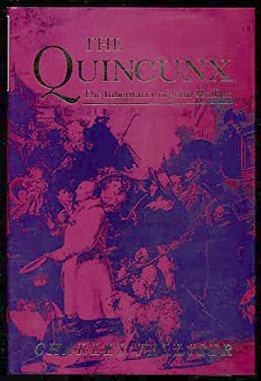A quincunx originally meant a 5/12 fraction of something, but most modern uses involve patterns of five points. "Quincunx" or "quincuncial" may in particular refer to
A quincunx originally meant a 5/12 fraction of something, but most modern uses involve patterns of five points. "Quincunx" or "quincuncial" may in particular refer to

In geometry, a cube is a three-dimensional solid object bounded by six square faces, facets, or sides, with three meeting at each vertex. Viewed from a corner, it is a hexagon and its net is usually depicted as a cross.

A quincunx is a geometric pattern consisting of five points arranged in a cross, with four of them forming a square or rectangle and a fifth at its center. The same pattern has other names, including "in saltire" or "in cross" in heraldry, the five-point stencil in numerical analysis, and the five dots tattoo. It forms the arrangement of five units in the pattern corresponding to the five-spot on six-sided dice, playing cards, and dominoes. It is represented in Unicode as U+2059⁙FIVE DOT PUNCTUATION or U+2684⚄DIE FACE-5.

In plane Euclidean geometry, a rhombus is a quadrilateral whose four sides all have the same length. Another name is equilateral quadrilateral, since equilateral means that all of its sides are equal in length. The rhombus is often called a "diamond", after the diamonds suit in playing cards which resembles the projection of an octahedral diamond, or a lozenge, though the former sometimes refers specifically to a rhombus with a 60° angle, and the latter sometimes refers specifically to a rhombus with a 45° angle.

The Garden of Cyrus, or The Quincuncial Lozenge, or Network Plantations of the Ancients, naturally, artificially, mystically considered, is a discourse by Thomas Browne concerned with the quincunx—a pattern of five points arranged in an X (⁙), as on a die —in art and nature. First published in 1658, along with its companion Urn-Burial, in modern times it has been recognised as Browne's major literary contribution to Hermetic wisdom.

In geometry, a diagonal is a line segment joining two vertices of a polygon or polyhedron, when those vertices are not on the same edge. Informally, any sloping line is called diagonal. The word diagonal derives from the ancient Greek διαγώνιος diagonios, "from angle to angle" ; it was used by both Strabo and Euclid to refer to a line connecting two vertices of a rhombus or cuboid, and later adopted into Latin as diagonus.

A wallpaper is a mathematical object covering a whole Euclidean plane by repeating a motif indefinitely, in manner that certain isometries keep the drawing unchanged. For each wallpaper there corresponds a group of congruent transformations, with function composition as the group operation. Thus, a wallpaper group is a mathematical classification of a two‑dimensional repetitive pattern, based on the symmetries in the pattern. Such patterns occur frequently in architecture and decorative art, especially in textiles, tessellations, tiles and physical wallpaper.

In geometry and group theory, a lattice in the real coordinate space is an infinite set of points in this space with the properties that coordinate-wise addition or subtraction of two points in the lattice produces another lattice point, that the lattice points are all separated by some minimum distance, and that every point in the space is within some maximum distance of a lattice point. Closure under addition and subtraction means that a lattice must be a subgroup of the additive group of the points in the space, and the requirements of minimum and maximum distance can be summarized by saying that a lattice is a Delone set. More abstractly, a lattice can be described as a free abelian group of dimension which spans the vector space . For any basis of , the subgroup of all linear combinations with integer coefficients of the basis vectors forms a lattice, and every lattice can be formed from a basis in this way. A lattice may be viewed as a regular tiling of a space by a primitive cell.
A pandiagonal magic square or panmagic square is a magic square with the additional property that the broken diagonals, i.e. the diagonals that wrap round at the edges of the square, also add up to the magic constant.

The quincunx was a bronze coin minted during the Roman Republic. It was not part of the standard coinage of the Roman monetary system. The quincunx was produced only during the Second Punic War, by mints at Luceria, Teate, Larinum, and northern Apulia. After the defeat of Cannae during the Second Punic War, a coin with the same value was minted in Capua.
André Alexis is a Canadian writer who was born in Port of Spain, Trinidad and Tobago, grew up in Ottawa, and now lives in Toronto, Ontario. He has received numerous awards including the Windham-Campbell Literature Prize, the Giller Prize, the Rogers Writers' Trust Fiction Prize, and the Trillium Award.
The crystallographic restriction theorem in its basic form was based on the observation that the rotational symmetries of a crystal are usually limited to 2-fold, 3-fold, 4-fold, and 6-fold. However, quasicrystals can occur with other diffraction pattern symmetries, such as 5-fold; these were not discovered until 1982 by Dan Shechtman.

In geometry, the rhombille tiling, also known as tumbling blocks, reversible cubes, or the dice lattice, is a tessellation of identical 60° rhombi on the Euclidean plane. Each rhombus has two 60° and two 120° angles; rhombi with this shape are sometimes also called diamonds. Sets of three rhombi meet at their 120° angles, and sets of six rhombi meet at their 60° angles.

In mathematics, the square lattice is a type of lattice in a two-dimensional Euclidean space. It is the two-dimensional version of the integer lattice, denoted as . It is one of the five types of two-dimensional lattices as classified by their symmetry groups; its symmetry group in IUC notation as p4m, Coxeter notation as [4,4], and orbifold notation as *442.

Slingo is an online single and multi-player game that combines elements of slots and bingo. The game was created by New Jersey real estate developer, Sal Falciglia Sr. in 1994, who also founded the company Slingo, Inc. to create and market games based on the Slingo theme. In July 2013, RealNetworks acquired Slingo for $15.6 million, and in July 2015 RealNetworks announced that it would sell Slingo to London-based gaming company Gaming Realms. Slingo has since become popular in the UK online gambling industry, with many sites now hosting the game, including its various iterations of which there are currently 12. These are known collectively and individually as ‘Slingo Originals’ and were developed by Gaming Realms’ development and publishing branch of the same name. Both the games and brand have enjoyed commercial success, and have been praised for their playability and originality.

The Peirce quincuncial projection is the conformal map projection from the sphere to an unfolded square dihedron, developed by Charles Sanders Peirce in 1879. Each octant projects onto an isosceles right triangle, and these are arranged into a square. The name quincuncial refers to this arrangement: the north pole at the center and quarters of the south pole in the corners form a quincunx pattern like the pips on the five face of a traditional die. The projection has the distinctive property that it forms a seamless square tiling of the plane, conformal except at four singular points along the equator.

The Quincunx (The Inheritance of John Huffam) is the epic first novel of Charles Palliser. It takes the form of a Dickensian mystery set in early 19th century England, but Palliser has added the modern attributes of an ambiguous plot and unreliable narrators. Many of the puzzles that are apparently solved in the story have an alternative solution in the subtext.
In mathematics, the matrix

In crystallography, a fractional coordinate system is a coordinate system in which basis vectors used to the describe the space are the lattice vectors of a crystal (periodic) pattern. The selection of an origin and a basis define a unit cell, a parallelotope defined by the lattice basis vectors where is the dimension of the space. These basis vectors are described by lattice parameters consisting of the lengths of the lattice basis vectors and the angles between them .

In mathematics, a matrix is a rectangular array or table of numbers, symbols, or expressions, arranged in rows and columns, which is used to represent a mathematical object or property of such an object.
An overlapping circles grid is a geometric pattern of repeating, overlapping circles of an equal radius in two-dimensional space. Commonly, designs are based on circles centered on triangles or on the square lattice pattern of points.